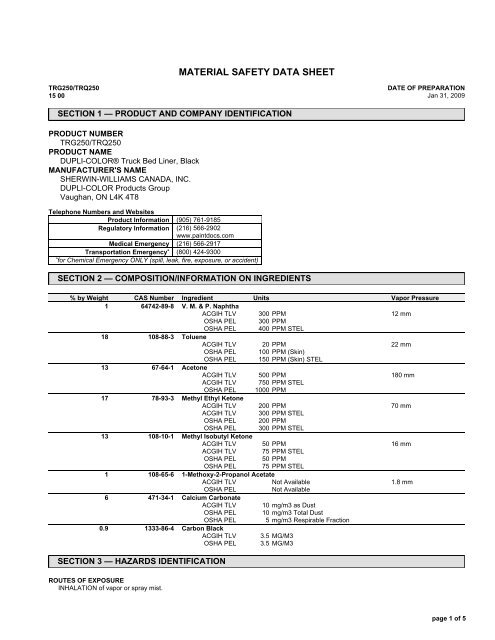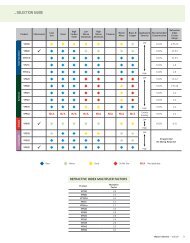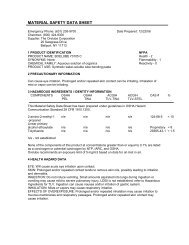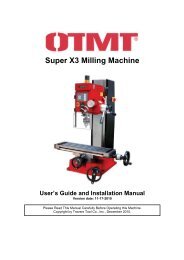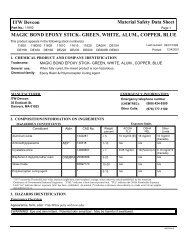Download Datasheet - Travers Tool Company, Inc.
Download Datasheet - Travers Tool Company, Inc.
Download Datasheet - Travers Tool Company, Inc.
Create successful ePaper yourself
Turn your PDF publications into a flip-book with our unique Google optimized e-Paper software.
MATERIAL SAFETY DATA SHEETTRG250/TRQ25015 00DATE OF PREPARATIONJan 31, 2009SECTION 1 — PRODUCT AND COMPANY IDENTIFICATIONPRODUCT NUMBERTRG250/TRQ250PRODUCT NAMEDUPLI-COLOR® Truck Bed Liner, BlackMANUFACTURER'S NAMESHERWIN-WILLIAMS CANADA, INC.DUPLI-COLOR Products GroupVaughan, ON L4K 4T8Telephone Numbers and WebsitesProduct Information (905) 761-9185Regulatory Information (216) 566-2902www.paintdocs.comMedical Emergency (216) 566-2917Transportation Emergency* (800) 424-9300*for Chemical Emergency ONLY (spill, leak, fire, exposure, or accident)SECTION 2 — COMPOSITION/INFORMATION ON INGREDIENTS% by Weight CAS Number Ingredient Units Vapor Pressure1 64742-89-8 V. M. & P. NaphthaACGIH TLV 300 PPM 12 mmOSHA PEL 300 PPMOSHA PEL 400 PPM STEL18 108-88-3 TolueneACGIH TLV 20 PPM 22 mmOSHA PEL 100 PPM (Skin)OSHA PEL 150 PPM (Skin) STEL13 67-64-1 AcetoneACGIH TLV 500 PPM 180 mmACGIH TLV 750 PPM STELOSHA PEL 1000 PPM17 78-93-3 Methyl Ethyl KetoneACGIH TLV 200 PPM 70 mmACGIH TLV 300 PPM STELOSHA PEL 200 PPMOSHA PEL 300 PPM STEL13 108-10-1 Methyl Isobutyl KetoneACGIH TLV 50 PPM 16 mmACGIH TLV 75 PPM STELOSHA PEL 50 PPMOSHA PEL 75 PPM STEL1 108-65-6 1-Methoxy-2-Propanol AcetateACGIH TLV Not Available 1.8 mmOSHA PELNot Available6 471-34-1 Calcium CarbonateACGIH TLV 10 mg/m3 as DustOSHA PEL 10 mg/m3 Total DustOSHA PEL 5 mg/m3 Respirable Fraction0.9 1333-86-4 Carbon BlackACGIH TLV 3.5 MG/M3OSHA PEL 3.5 MG/M3SECTION 3 — HAZARDS IDENTIFICATIONROUTES OF EXPOSUREINHALATION of vapor or spray mist.page 1 of 5
TRG250/TRQ250EYE or SKIN contact with the product, vapor or spray mist.EFFECTS OF OVEREXPOSUREEYES: Irritation.SKIN: Prolonged or repeated exposure may cause irritation.INHALATION: Irritation of the upper respiratory system.HMIS CodesHealth 2*Flammability 3Reactivity 0May cause nervous system depression. Extreme overexposure may result in unconsciousness and possibly death.Prolonged overexposure to solvent ingredients in Section 2 may cause adverse effects to the liver, urinary, blood forming, cardiovascular andreproductive systems.SIGNS AND SYMPTOMS OF OVEREXPOSUREHeadache, dizziness, nausea, and loss of coordination are indications of excessive exposure to vapors or spray mists.Redness and itching or burning sensation may indicate eye or excessive skin exposure.MEDICAL CONDITIONS AGGRAVATED BY EXPOSURENone generally recognized.CANCER INFORMATIONFor complete discussion of toxicology data refer to Section 11.SECTION 4 — FIRST AID MEASURESEYES:SKIN:INHALATION:INGESTION:Flush eyes with large amounts of water for 15 minutes. Get medical attention.Wash affected area thoroughly with soap and water.Remove contaminated clothing and launder before re-use.If affected, remove from exposure. Restore breathing. Keep warm and quiet.Do not induce vomiting. Get medical attention immediately.SECTION 5 — FIRE FIGHTING MEASURESFLASH POINTLEL UEL FLAMMABILITY CLASSIFICATION10° F PMCC0.913.1 RED LABEL -- Extremely Flammable, Flash below 21° F (-6 °C)EXTINGUISHING MEDIACarbon Dioxide, Dry Chemical, FoamUNUSUAL FIRE AND EXPLOSION HAZARDSClosed containers may explode when exposed to extreme heat.Application to hot surfaces requires special precautions.During emergency conditions overexposure to decomposition products may cause a health hazard. Symptoms may not be immediatelyapparent. Obtain medical attention.SPECIAL FIRE FIGHTING PROCEDURESFull protective equipment including self-contained breathing apparatus should be used.Water spray may be ineffective. If water is used, fog nozzles are preferable. Water may be used to cool closed containers to prevent pressurebuild-up and possible autoignition or explosion when exposed to extreme heat.SECTION 6 — ACCIDENTAL RELEASE MEASURESSTEPS TO BE TAKEN IN CASE MATERIAL IS RELEASED OR SPILLEDRemove all sources of ignition. Ventilate the area.Remove with inert absorbent.SECTION 7 — HANDLING AND STORAGESTORAGE CATEGORYDOL Storage Class IBPRECAUTIONS TO BE TAKEN IN HANDLING AND STORAGEContents are EXTREMELY FLAMMABLE. Keep away from heat, sparks, and open flame. Vapors will accumulate readily and may igniteexplosively.During use and until all vapors are gone: Keep area ventilated - Do not smoke - Extinguish all flames, pilot lights, and heaters - Turn offstoves, electric tools and appliances, and any other sources of ignition.Consult NFPA Code. Use approved Bonding and Grounding procedures.Keep container closed when not in use. Transfer only to approved containers with complete and appropriate labeling. Do not take internally.Keep out of the reach of children.SECTION 8 — EXPOSURE CONTROLS/PERSONAL PROTECTIONPRECAUTIONS TO BE TAKEN IN USEUse only with adequate ventilation.Avoid contact with skin and eyes. Avoid breathing vapor and spray mist.Wash hands after using.page 2 of 5
TRG250/TRQ250This coating may contain materials classified as nuisance particulates (listed "as Dust" in Section 2) which may be present at hazardous levelsonly during sanding or abrading of the dried film. If no specific dusts are listed in Section 2, the applicable limits for nuisance dusts areACGIH TLV 10 mg/m3 (total dust), 3 mg/m3 (respirable fraction), OSHA PEL 15 mg/m3 (total dust), 5 mg/m3 (respirable fraction).Removal of old paint by sanding, scraping or other means may generate dust or fumes that contain lead. Exposure to lead dust or fumes maycause brain damage or other adverse health effects, especially in children or pregnant women. Controlling exposure to lead or otherhazardous substances requires the use of proper protective equipment, such as a properly fitted respirator (NIOSH approved) and propercontainment and cleanup. For more information, call the National Lead Information Center at 1-800-424-LEAD (in US) or contact your localhealth authority.VENTILATIONLocal exhaust preferable. General exhaust acceptable if the exposure to materials in Section 2 is maintained below applicable exposure limits.Refer to OSHA Standards 1910.94, 1910.107, 1910.108.RESPIRATORY PROTECTIONIf personal exposure cannot be controlled below applicable limits by ventilation, wear a properly fitted organic vapor/particulate respiratorapproved by NIOSH/MSHA for protection against materials in Section 2.When sanding or abrading the dried film, wear a dust/mist respirator approved by NIOSH/MSHA for dust which may be generated from thisproduct, underlying paint, or the abrasive.PROTECTIVE GLOVESWear gloves which are recommended by glove supplier for protection against materials in Section 2.EYE PROTECTIONWear safety spectacles with unperforated sideshields.OTHER PRECAUTIONSIntentional misuse by deliberately concentrating and inhaling the contents can be harmful or fatal.SECTION 9 — PHYSICAL AND CHEMICAL PROPERTIESPRODUCT WEIGHT 8.06 lb/gal 965 g/lSPECIFIC GRAVITY 0.97BOILING POINT 132 - 325° F 55 - 162° CMELTING POINT Not AvailableVOLATILE VOLUME 75%EVAPORATION RATE Slower than etherVAPOR DENSITY Heavier than airSOLUBILITY IN WATER N.A.VOLATILE ORGANIC COMPOUNDS (VOC Theoretical - As Packaged)4.89lb/gal 585g/l Less Water and Federally Exempt Solvents4.13lb/gal 495g/l Emitted VOCSECTION 10 — STABILITY AND REACTIVITYSTABILITY — StableCONDITIONS TO AVOIDNone known.INCOMPATIBILITYNone known.HAZARDOUS DECOMPOSITION PRODUCTSBy fire: Carbon Dioxide, Carbon Monoxide , Hydrogen ChlorideHAZARDOUS POLYMERIZATIONWill not occurSECTION 11 — TOXICOLOGICAL INFORMATIONCHRONIC HEALTH HAZARDSMethyl Ethyl Ketone may increase the nervous system effects of other solvents.Reports have associated repeated and prolonged overexposure to solvents with permanent brain and nervous system damage.Carbon Black is classified by IARC as possibly carcinogenic to humans (group 2B) based on experimental animal data, however, there isinsufficient evidence in humans for its carcinogenicity.page 3 of 5
TRG250/TRQ250TOXICOLOGY DATACAS No.Ingredient Name64742-89-8 V. M. & P. NaphthaLC50 RAT 4HR Not AvailableLD50 RATNot Available108-88-3 TolueneLC50 RAT 4HR 4000 ppmLD50 RAT5000 mg/kg67-64-1 AcetoneLC50 RAT 4HR Not AvailableLD50 RAT5800 mg/kg78-93-3 Methyl Ethyl KetoneLC50 RAT 4HR Not AvailableLD50 RAT2740 mg/kg108-10-1 Methyl Isobutyl KetoneLC50 RAT 4HR Not AvailableLD50 RAT2080 mg/kg108-65-6 1-Methoxy-2-Propanol AcetateLC50 RAT 4HR Not AvailableLD50 RAT8500 mg/kg471-34-1 Calcium CarbonateLC50 RAT 4HR Not AvailableLD50 RATNot Available1333-86-4 Carbon BlackLC50 RAT 4HR Not AvailableLD50 RATNot AvailableSECTION 12 — ECOLOGICAL INFORMATIONECOTOXICOLOGICAL INFORMATIONNo data available.SECTION 13 — DISPOSAL CONSIDERATIONSWASTE DISPOSAL METHODWaste from this product may be hazardous as defined under the Resource Conservation and Recovery Act (RCRA) 40 CFR 261.Waste must be tested for ignitability to determine the applicable EPA hazardous waste numbers.<strong>Inc</strong>inerate in approved facility. Do not incinerate closed container. Dispose of in accordance with Federal, State/Provincial, and Localregulations regarding pollution.SECTION 14 — TRANSPORT INFORMATIONUS Ground (DOT)1 Gallon and Less may be Classed as CONSUMER COMMODITY, ORM-DLarger Containers are Regulated as:UN1263, PAINT, 3, PG II, (ERG#128)DOT (Dept of Transportation) Hazardous Substances & Reportable QuantitiesEthyl methyl ketone 5000 lb RQToluene 1000 lb RQBulk Containers may be Shipped as (check reportable quantities):UN1263, PAINT, 3, PG II, (ERG#128)Canada (TDG)UN1263, PAINT, CLASS 3, PG II, (ERG#128)IMOUN1263, PAINT, CLASS 3, PG II, (-12 C c.c.), EmS F-E, S-ESECTION 15 — REGULATORY INFORMATIONSARA 313 (40 CFR 372.65C) SUPPLIER NOTIFICATIONCAS No. CHEMICAL/COMPOUND % by WT % Element108-88-3 Toluene 18108-10-1 Methyl Isobutyl Ketone 13TSCA CERTIFICATIONAll chemicals in this product are listed, or are exempt from listing, on the TSCA Inventory.page 4 of 5
TRG250/TRQ250SECTION 16 — OTHER INFORMATIONThis product has been classified in accordance with the hazard criteria of the Canadian Controlled Products Regulations (CPR) and theMSDS contains all of the information required by the CPR.The above information pertains to this product as currently formulated, and is based on the information available at this time. Addition of reducers or otheradditives to this product may substantially alter the composition and hazards of the product. Since conditions of use are outside our control, we make nowarranties, express or implied, and assume no liability in connection with any use of this information.page 5 of 5


